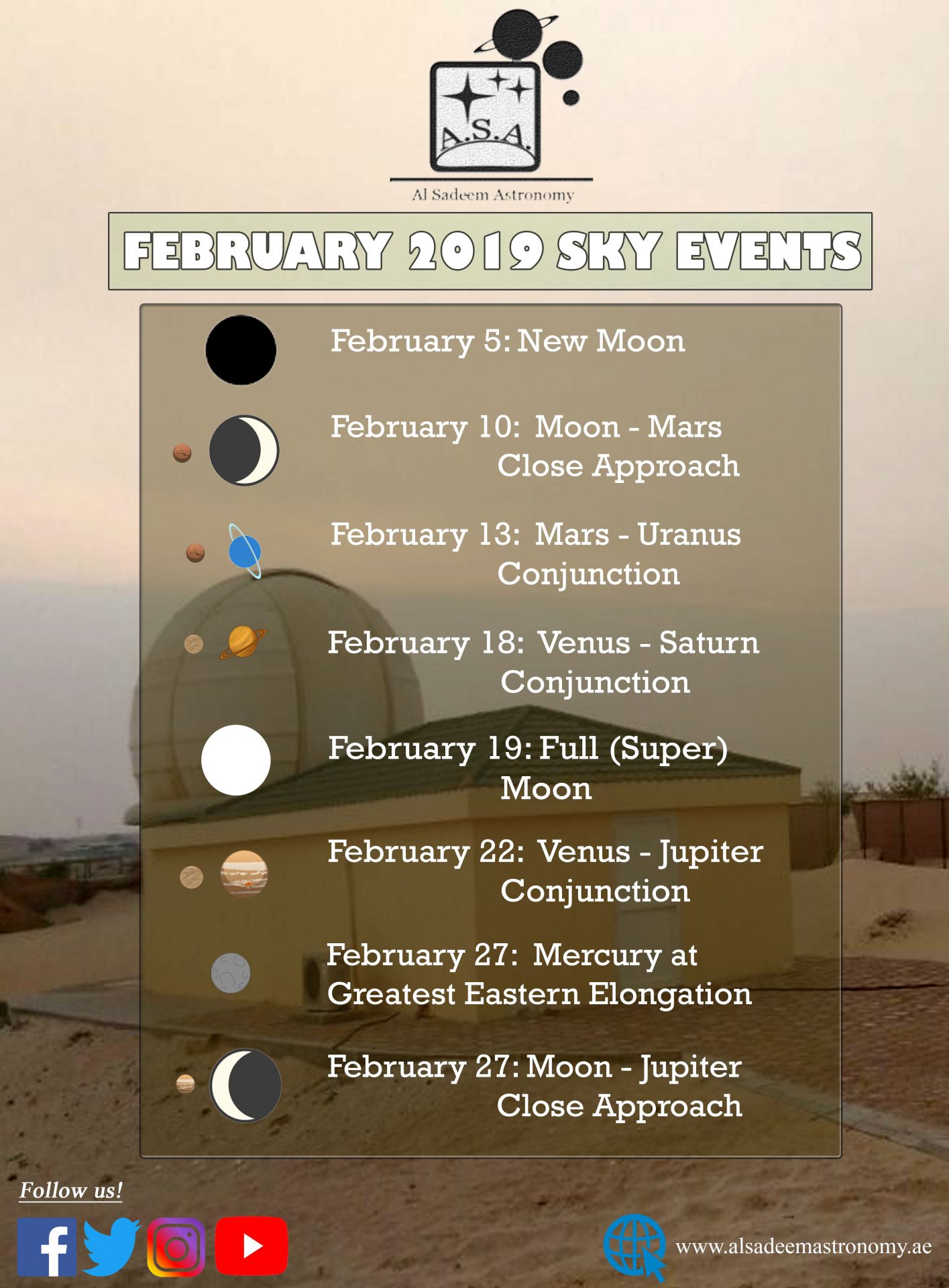February opens with the gradual exit of the Moon from the night sky, which means observers will start the second month with a trove of prominent bright winter constellations such as Orion, Taurus, Auriga and Gemini and spring constellations like Ursa Major, Leo and Virgo after midnight.
Several deep-sky objects such as the Orion Nebula, Flame and Horsehead Nebula, Crab Nebula, Messier 53 and Pinwheel Galaxy can also be observed under relatively clear, moonless and dark skies.
Planets Mars and Uranus are going to be a regular sight right after sunset, while the bright planets Venus, Jupiter, and Saturn will be gracing the night sky in the early morning hours until sunrise.
Meanwhile, there will be barely or no sighting at all of planets Mercury and Neptune because of their nearness to the Sun as seen in the sky.
Days are still long, with late sunrises from 6:46 to 7:04 in the morning and early sunsets from 6:04 P.M. to 6:24 in the evening.
For more serious sky watching,Al Sadeem Astronomy has prepared below a calendar for February’s sky events.All dates and times were given in UAE Local Time (UTC+4).
FEBRUARY 5: NEW MOON
The moon will not be visible in the night sky, because it will be situated on the same side of the Earth as the Sun—specifically in the constellation of Capricorn (The Goat). This is the best time to observe deep-sky objects, such as the Orion Nebula, Horsehead and Flame Nebula, as well as the Pleiades and fainter ones like the Crab Nebula and globular cluster Messier 53. The month transition from Djumada l-Ula to Djumada l-Akhira shall take place two days later (February 7) in accordance with the Hijri Calendar 1440.
FEBRUARY 10: CLOSE APPROACH OF THE MOON AND MARS
The waxing crescent Moon—about 23% illuminated—will be at 6°04’ southwest of the red planet Mars in the early hours of the evening, with the pair appearing at the southwestern part of the horizon right after sunset at around 6:30 P.M.Situated in the faint constellation Pisces (The Fishes), the Moon and planet Mars will both set at around 10:45 PM.

FEBRUARY 14: MARS-URANUS CONJUNCTION
The red planet Mars and the faint bluish planet Uranus will appear close to each other in the early evening hours of this day, particularly right after sunset until 10:45 PM. The planet pair will be separated 1°03’ from each other, and will be both spotted in the constellation of Aries (The Ram). Capturing the conjunction requires long-exposure photography, preferably with a long camera zoom (preferably 100-400 mm) lens.

FEBRUARY 18: VENUS-SATURN CONJUNCTION
The two bright planets Venus and Saturn will appear close to each other at dawn on this day. The two planets will be 1°05’ apart in the constellation of Sagittarius (The Archer), which will be seen at the southeastern portion of the sky from 4:45 AM until sunrise. Venus is the brighter object situated a degree northwest of Saturn. Also seen to the far northeast of the pair is the gas giant Jupiter.

FEBRUARY 19: FULL MOON AT PERIGEE (SUPERMOON)
There’s a hundred percent illumination of the moon, and selenophiles—or those people who have a strong penchant for the moon—will be in for a treat as this is the best time to observe all the surface features of the Earth’s natural satellite, including its craters and lunar maria, or the large, dark, basaltic plains on Earth’s Moon.As early as 6:20 P.M., the Moon will show itself at the east-northeastern horizon in the constellation of Leo (The Lion).

The Moon will also be at its perigee—or its distance closest to the Earth, making it appear approximately 7 percent bigger and 16 percent brighter than the usual full Moon. This is the second in the “Supermoon Trilogy,” or the three consecutive occurrences of Supermoons for 2019.
FEBRUARY 27: MERCURY AT GREATEST EASTERN ELONGATION
Mercury, the smallest and closest planet from the Sun, will be at its highest point in the sky, beginning at sunset (around 6:35 PM) until disappearing from view as it sets at around 7:10 PM.Because of its close proximity to the Sun, it would be a challenge to observe the planet with its maximum extent of angular separation from the Sun—as seen from Earth— 11° above the western horizon in the UAE sky.

FEBRUARY 27: CLOSE APPROACH OF THE MOON AND JUPITER
The moon and planet Jupiter will appear close to each other (around 2°19’ angular separation) at the sky when viewed from Earth. This close approach will be visible at eastern portion of the sky in the constellation of Ophiuchus (The Serpent Bearer) from around 5 AM until sunrise. The moon will be at the Waning Crescent phase (about 8% illuminated). Jupiter would appear as a brilliant white “star” northwest of the Moon.



REFERENCES
- Astronomy Calendar of Celestial Events 2019. (n.d.). Retrieved from Sea and Sky: www.seasky.org/astronomy/astronomy-calendar-2019.html
- Calendar of Astronomical Events. (n.d.). Retrieved from In-The-Sky.org: http://in-the-sky.org/newscal.php?year=2019&month=2&maxdiff=4 #datesel
- Islamic calendar 2019. (n.d.). Retrieved from Calendar.sk: https://calendar.zoznam.sk/islamic_calendar-en.php?ly=2019
- McClure, B., & Byrd, D. (2019, January 1). How many supermoons in 2019? Retrieved from https://earthsky.org/?p=172164
- Sunrise and sunset times in Abu Dhabi, February 2019. (n.d.). Retrieved from timeanddate.com: https://www.timeanddate.com/sun/united-arab-emirates/abu-dhabi?month=2&year=2019

